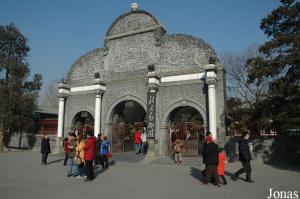Zoological collections in China: past, present... and future?
I have had the good fortune to visit thirty Chinese zoos, mostly during three trips in 2007, in January and February, then in July and lastly in December. I went to Asia for the first time in 2001, when I stayed on the island of Taiwan for about ten days. On that occasion I spent a day at Taipei Zoo, which opened in 1986 and covers an area of nearly 165 hectares. My memories of that visit are of a very big zoo, with animal exhibits which were sometimes enormous but also often artificial. Some areas, however, were much more natural, with thick tropical vegetation. The Butterfly Forest was a particularly impressive discovery at Taipei Zoo. I had the opportunity to go back to Asia in 2004, this time to Hong Kong. This territory, because of its unusual history and its current status as a Special Administrative Region of the People's Republic of China, is still very different from China. The same can be said of the various zoological collections in Hong Kong compared to those in China proper. But it is quite easy to use Hong Kong as a point of entry when making one's first acquaintance with China. Thus, on this same trip, I spent a day in Macao, China's other Special Administrative Region. The Jardim da Flora and the Parque de Seac Pai Van, two little local zoos, gave me a first glimpse of the animals' housing conditions in Chinese zoos and allowed me to learn something about their characteristics. But I had to wait until January 2007 and another trip to begin to understand the full picture. On the morning of 29 January 2007, I went through the large entrance porch of the famous Beijing Zoological Gardens...
China, a land of contrasts, extremes and diversities
China, or to be more precise the People's Republic of China, is now the most populous country in the world with over 1.3 billion people. It is also ranked third (after Russia and Canada) in area, with nearly ten million square kilometres. The Human Development Index (HDI) is the normalized measure of life expectancy, literacy, education, standard of living and gross domestic product (GDP) for countries worldwide. According to the World Report on Human Development 2007/2008, China's HDI now stands at 0.777, ranking 81st, which represents a medium development. It should be noted that China has risen by 14 places since 1990 and is considered to have made the most significant progress in the index. It is a good bet that China will enter the category of countries with high human development in the coming decades. The 'Middle Kingdom' is now also the world's second largest economic power based on its GDP and its Purchasing Power Parity (PPP), and is ranked fourth according to the traditional monetary criteria. Besides, though it is still officially a communist country, it has adopted a socialist market economy, combining economic liberalism and political authoritarianism in a unique formula.
Biodiversity is particularly important in China as a consequence of the huge size of the country and its great variety of habitats. As regards vertebrates, it ranks as one of the five richest countries in the world, which is quite remarkable in view of its largely temperate climate. More than 1,300 species of bird, 500 mammals, 300 reptiles and 200 amphibians are listed in the territory, with a rate of endemism which is far from negligible.
Ancient history and recent discoveries
As was the case in many other countries, some Chinese people already had private menageries several centuries before the Christian era. The majority of them had been created for ornamental, hunting or fishing purposes. Historical documents on this subject are unfortunately few, so it is difficult to assess the type of relationship the Chinese people had with animals at the time. At the end of the 13th century the great traveller Marco Polo described the menageries of the Mongols after his arrival in China in 1271. His attention and curiosity were mainly attracted by the Emperor Kublai Khan's menageries. Over the centuries, other Chinese lords and emperors developed facilities where they kept exotic animals, but none of them really made their mark on history.
The Frenchman Father Armand David (1826-1900), a Catholic priest and Lazarist missionary, made several journeys in China and sent many specimens of wild fauna and flora back to Europe. Among other things, he discovered the famous Père David's deer (Elaphurus davidianus) in the imperial hunting park south of Beijing, now known as Nan Hai-tsu Park. In 1869 he also became the first Westerner to discover the giant panda (Ailuropoda melanoleuca).
Beijing Zoological Gardens, the first Chinese zoo
The first true zoo to be opened to the public in China was probably Peking Zoo, or the Beijing Zoological Gardens. Founded in 1906, it was originally named Wan Sheng Yuan, the 'Garden of Ten Thousand Animals'. It then had an area of 3.5 hectares and was a section of Zhongyang Nongshi Shiyanchang, the 'Central Experimental Research Farm'. The creation of this research farm was one of the last efforts of the Qing (or Ch'ing) dynasty to modernise its science and technology institutes, before its final collapse in 1911. A commission had visited Europe and the United States in 1905-06 to study the national zoos of those regions and had returned with the recommendation to create a garden of acclimatization A first batch of animals was then ordered from the dealer Carl Hagenbeck in Hamburg. This consisted of 134 animals belonging to 58 species. Thereafter, the acquisition of Chinese species allowed the collection to increase.
Entrance of Beijing Zoo - January 2007
The Wan Sheng Yuan was inaugurated on 18 June 1908 and immediately proved to be popular in a society where zoological gardens were little known. After the proclamation of the Republic of China in January 1912, the Beijing Zoo experienced some difficulties. The problems were partially resolved by the end of the 1920s with the establishment of the Kuomintang regime, under Chiang Kai Shek's rule, but Beijing lost its status as capital city in 1928. The animal collection was then greatly reduced. Thereafter, Beijing was occupied by the Japanese from 1937 until 1945, after which the civil war began between the Kuomintang and the communists of Mao Zedong. When Beijing was once again declared the capital in 1949, the zoo had only one blind emu, three parrots and a dozen monkeys.
The communists were determined to transform it into a national institution, so in 1950 they re-opened the Central Experimental Research Farm. Then the whole area was devoted to the zoo, which became the Beijing Dongwuyuan, the 'Beijing Zoological Gardens', on 10 April 1955. In 1958 the area was expanded to 35 hectares. Many buildings and facilities were constructed and the animal collection increased regularly each year.
Finally, since the inauguration of a new aquarium and new exhibits for pachyderms in 1999, Beijing Zoo has had some thirty facilities covering an area of 90 hectares. The animal collection now consists of approximately 15,000 animals of nearly 1,600 species.
The organising of the 2008 Beijing Olympic Games has provided an opportunity for a new wave of renovations and new construction. It had been initially planned to totally destroy the zoo and rebuild it on the outskirts of the city in order to construct the Olympic Village, but that idea was quickly abandoned. New species, such as the koalas offered by Australia, will be introduced in 2008. Renovations have also been planned, and during my visit in January 2007 all the former zone of bear dens and cat cages had already been demolished.
Other zoological parks built in the early 20th century
Other zoological gardens were created in several Chinese cities in the early 20th century. Among others, the Chengdu Municipal Menagerie was established in 1909. Around the same time, Qingdao acquired a zoo during the city's 1898-1922 German occupation. Another zoo was established in Canton (now Guangzhou). But most of them did not survive the periods of turmoil that followed in China, and they were replaced by new parks in the second half of the 20th century.
A new political situation leads to the foundation of urban zoos
The proclamation of the communist regime in 1949 gave a new impetus to the creation of zoos. They were intended to give people a collective entertainment and access to culture; they were most often built in big cities which were themselves under development. The Shanghai Zoo, which was inaugurated on 25 May 1954, is certainly the best known and most important example. Chengdu Zoo was inaugurated in 1953, Guangzhou Zoo in 1958, Qingdao Zoo in 1977, and there are many other examples. Most of them were conceived on oldfashioned principles, with an accumulation of cage rows and concrete pits. Few of them have been renovated or even improved over the decades. Even when they were built in urban areas, these zoos were usually quite extensive - 16 hectares in Chengdu, 31 in Qingdao, 42 in Guangzhou and even 74 in Shanghai. The number of animals and species was also important - 3,900 animals of 450 species in Shanghai, 4,000 animals of 400 species in Guangzhou, more than 250 species in Chengdu. So, once again, we realize that China is a land of extremes.
A milestone was reached in 1985 when the Chinese Association of Zoological Gardens (CAZG) was founded. This association quickly gathered together more than 150 zoological collections in the country. In the late 1980s, several courses were organized in collaboration with American zoos in order to teach Chinese zoo professionnals about the role of modern zoos as well as the maintenance of exotic species in captivity. A captive breeding programme was set up for the rare South China tiger (Panthera tigris amoyensis) and intensified reproductive efforts were made for the giant panda.
All this has helped a great deal to improve the management of captive populations in Chinese zoos, but there is still a lot to do - in particular to enhance the well-being of each individual animal. The Western visitor cannot help being surprised by the lack of enrichment in the various facilities. The root of the problem is not really the enclosures in themselves, or their surfaces or their general design, but their internal fittings. All these town zoos, constructed over the past half-century, have features in common: the buildings are impressive and there are lots of animal exhibits. Concrete and other non-natural materials have often been used to an excessive extent, but this need not have prevented each animal's living space from being enriched.
Conservation and research are quite well developed in China, especially as regards species that are emblematic. But what about education? Unfortunately it still remains limited in the majority of the zoos I visited in 2007. The signs are often small and unattractive, with insufficient information. Moreover, the species identifications provided are often inaccurate, or even fictitious. On the other hand, some Chinese aquariums - as we will see later - have been able to develop rich educational programmes, an example which should be followed by the zoos.
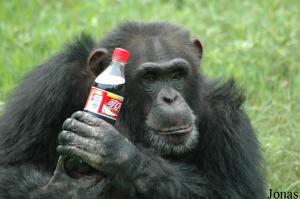
Male chimp addicted to Coca-Cola in
Shanghai Wild Animal Park - July 2007
Chinese visitors are sometimes relatively undisciplined and have little respect for animals. It is unfortunately a common practice to give a golden snub-nosed monkey or François's langur a banana through the mesh of the cage or to throw a stone at a Chinese tiger to make it move. At Shanghai Wild Animal Park I even saw a chimpanzee who had become addicted to Coca-Cola supplied by visitors. Despite these incidents, however, all my visits in 2007 suggested that we can be relatively optimistic about that problem. There seem to have been favourable developments in recent years.
It should be noted that a typical large Chinese zoo generally attracts millions of visitors a year. The best score has been registered at Beijing Zoo with about 8 to 12 million visitors per year. Shanghai Zoo welcomes a little more than 2.5 million a year. Much the same is the case for all important Chinese zoos. They represent a very high potential for education and increasing respect for nature and wildlife.
Educational interpretations with animals of the kind which are well established in Western countries unfortunately do not exist in Chinese zoos. Animal shows are quite frequent, however: elephants, marine mammals, big cats and primates participate in daily and repetitive shows. This subject will be discussed later when we deal with the new zoological collections that opened during the 1990s.
Finally, people's entertainment seems to be taken into account in China thanks to these various shows. Many other attractions and exciting rides are also noteworthy. However, children's playgrounds with swings, slides and other structures are totally absent, showing again how different our cultures are.
Apart from the numerous large zoos, there are also smaller collections. They are often situated in public parks such as Heping Park and Yangpu Park in Shanghai. The cages and barriers are mostly old and obsolete. There is a conspicuous lack of overall organization, in contrast with traditional zoos. Finally, animal welfare is often taken into account very little, even less than in most big zoos.
A new development of the 1990s - the Wild Animal Parks
It is difficult to discover exactly where it all began, but the Safari Park Shenzhen, inaugurated in 1993, is often considered to have been the first park of the new type. Among other characteristics to be mentioned later, the possibility of visiting some enclosures by car was a really great innovation. The concept of the safari park was originally developed in Europe and North America in the late 1960s and early 1970s. In Shenzhen, there were at the beginning only a few small enclosures for bears, lions, tigers... Then the concept was broadened and developed with, among others, the inauguration of the Shanghai Wild Animal Park in 1995. Dozens of similar parks were built in China during the following years: the Badaling Safari World at the foot of the Great Wall, a few dozen kilometres north of Beijing, the Xiangjiang Safari Park on the outskirts of Guangzhou, the Chengdu Wildlife World, the Qingdao Forest Wildlife World, the Bifengxia Wild Animal Park to the south of Chengdu, and many more. At the moment, China has probably nearly a hundred zoological collections of that kind.
But what exactly is a Chinese wild animal park? Without having ever visited any zoos in the United States, I feel that they have influenced the wild animal parks of China. In many postcards of American zoos from the 1970s, we find some typical features that are very much in evidence today in the Chinese parks, such as show arenas, minibus tours and omnipresent crowds.
A visit to such a park falls into two parts - a ride round the safari section and a tour on foot through a more traditional zoo. Most of these parks have been built on a large scale, with an area of more than 100 hectares, sometimes even several hundred. Though the sites have often been chosen with a view to tourism, or at least because they are quite easily accessible, they are generally in beautiful natural settings - an area of lakes and swamps for the Shanghai park, a beautiful forest at Bifengxia, a site with canyons and rocky hills below the Great Wall at Badaling... Such areas provide a really ideal environment to exhibit exotic animals, but unfortunately the natural aspect has not been developed and is even sometimes totally ignored. Moreover such large areas oblige the visitors to take little electric cars to visit parts they could otherwise visit on foot.
A rapid analysis of published figures about animal collections also reveals excesses of scale: there are generally more than 10,000 or even 20,000 animals in each park, and several hundred species. Although these figures may seem somewhat exaggerated to attract the public, a visit to a Chinese wild animal park is always an impressive experience.
Most of the species, naturally, belong to the local fauna: breeding groups of Sichuan takins (Budorcas taxicolor tibetana), groups of golden snub-nosed monkeys (Pygathrix roxellana), François's langurs (Trachypithecus francoisi) and many other Chinese species. Giant pandas and Chinese red pandas (Ailurus fulgens styani) also have an important place and can be seen in most of these parks in more or less comfortable facilities.
African species are also often present, with large groups of ungulates including giraffes, hippopotamuses, white rhinos etc. Some of these animals are probably imported directly from Africa: certainly China is known to be one of the biggest importers of live white rhinos, and in 2007 I saw dozens of young individuals. The Xiangjiang Safari Park, Guangzhou, had no fewer than seven of them when I visited it in December. South American species are also well represented, in particular small primates such as saimiris and even spider monkeys. Big carnivores (bears, lions, tigers and other big cats) are of course a great attraction in safari parks. They are often exhibited in groups of several dozen individuals. In January, for example, I saw more than 35 lions - most of them males - in the same enclosure at Badaling Safari World. Cheetahs are sometimes in areas you can visit by car, whereas snow leopards can be seen in zones you can walk around.
The presence of some species can be very surprising. One of my most unexpected discoveries was probably when I saw a group of six young black-shanked douc langurs (Pygathrix nigripes) at Xiangjiang Safari Park in December 2007. Their exact origin is still very mysterious.
International collaborations and animal exchanges are sometimes organized. Thus in 2006 Xiangjiang Safari Park received six koalas from Currumbin Wildlife Sanctuary, Australia. These animals had already bred by August 2006 and twins were born on 16 October of the same year. In December 2007 the park was exhibiting ten koalas. I had never before seen such a number of this species at the same location.
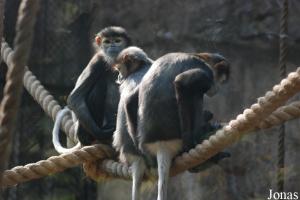
Black-shanked douc langurs in Xiangjiang Safari Park Guangzhou - December 2007
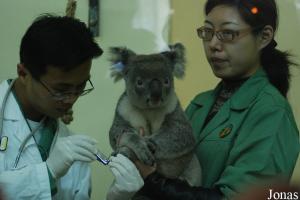
Koala in Xiangjiang Safari Park Guangzhou - December 2007
Reptiles are relatively poorly represented in Chinese wild animal parks, except of course the traditional Chinese alligators. There are sometimes Nile crocodiles or salt-water crocodiles and some snake species. Chinese giant salamanders (Andrias davidianus), so rare in captivity in Europe, are well represented in Chinese parks. As far as birds are concerned, the number of species exhibited is variable. Visitors can sometimes see owls in small aviaries, but birds are generally housed in large walk-through aviaries. There is usually only one aviary in a park, and they are frequently gigantic: they sometimes cover more than a hectare of land and the vegetation is often luxuriant. The net height is also important, sometimes several tens of metres. The aviary at Bifengxia Wild Animal Park is particularly impressive. The species that live together in such structures are very diversified, including cranes, waterfowl, corvids and gulls.
Another characteristic of Chinese wild animal parks, unfortunately, is the impressive number of animal shows which are daily offered to visitors. Mainly big cats, bears, elephants, monkeys and marine mammals endure humiliating circus-style performances. Captive animals may very well be a wonderful means of transmission of knowledge and respect, but animals in Chinese shows are not considered that way. There is nothing natural or educational about listening to thundering music or hearing the shouts of spectators and trainers, who are sometimes numerous in the ring, or even about seeing combinations of animals belonging to totally different species - quite the reverse. It would be difficult to describe all the horrors observed during these shows. Last July I was particularly shocked by a boxing match between Asiatic black bears during a show at Shanghai Wild Animal Park; moreover, the animals had to keep moving around on their hind legs the whole time. The show ended with the display of a golden snub-nosed monkey, such a rare and delicate animal!
The facilities used to hold the animals between performances are also far from appropriate - they are usually simply kept in small cages. The safety of visitors is also questionable. The picture of visitors walking in the ring among five elephants - four of them males - is strongly imprinted on my memory. Moreover, the trainers were paying very little attention to what was going on in the ring.
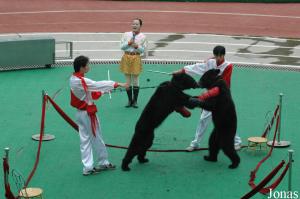
Boxing match between bears in Shanghai Wild Animal Park - July 2007

Elephants show in Shanghai Zoo - July 2007
In addition to all these shows, people also have the chance to be photographed with animals. Throughout their visit they can stand on small squares in front of an elephant, a black bear or even a tiger, and can approach the animal for the picture. In this case again, animal welfare is not taken into account. Moreover the practice is not without danger, and several accidents have already been reported.
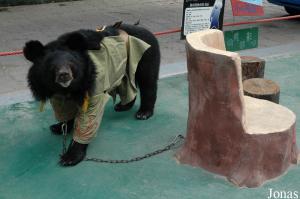
Photography scene with a bear in Safari Park Shenzhen - December 2007
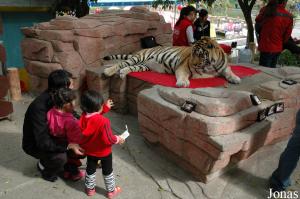
Photography scene with a tiger in Safari Park Shenzhen - December 2007
Feeding live animals to big carnivores is a custom which has been known since the end of the 1990s. I remember very well one morning in the summer of 1999, as I was preparing to visit Augsburg Zoo in Germany. I came upon an impressive photograph in a local paper which showed a cow among several big lions. The image, taken at Badaling Safari World, had been broadcast throughout Europe and had scandalized many people and organisations. But these practices have kept developing and still exist nowadays. At Shanghai Wild Animal Park live chickens are hung on cars which cross the enclosures of the big carnivores. The predator-prey relationship is not always so easy, and the film shot by Pierre Livet in June 2007 at Qingdao Wildlife World is particularly expressive. In the manner of a performance before the crowds in a Roman amphitheatre, a cow was put in front of a pair of lions. People would probably have expected the cow to be killed quickly, but a kind of running, chasing 'game' and face-to-face encounters began which lasted for more than twenty minutes. The lions sometimes even stepped back when confronted by the cow. Finally the male lion threw the cow to the ground and took a firm grip on her throat. Then the park staff intervened to prevent a killing; they drove the lions back into their cage and rescued the cow. In this park, visitors could also buy poultry or goats which were thrown to big cats in their dens.
The majority of Chinese wild animal parks have been created for commercial purposes. Such facilities require considerable investment and their real profit is sometimes uncertain. Indeed, some of them have already had to close down. In July 2007 I found myself in front of a vast barred entrance to Chengdu Wildlife World in Jintang, about thirty kilometres north of Chengdu. The park had opened in early 2002 and covered a large area. It had - like all Chinese wild animal parks - an important collection of animals and imposing buildings and facilities. I was told that it had definitely closed its doors in March 2007, after running for only five years. The huge entrance porch was already falling in ruins, and it felt strange to be reminded of the uncontrolled growth which so often characterises this country, but also of its ephemeral side.
However, the first Chinese wild animal parks opened in the mid-1990s are gradually developing. In December 2007, important work was under way at Safari Park Shenzhen in order to change the former area toured by bus into one visited on foot. The old roads are going to be replaced by elevated walkways from which visitors will be able to get a good view of the animals. The Xiangjiang Safari Park in Guangzhou, probably one of the best zoos - if not the very best - in China, was also completely transformed in 2004. The ride round is no longer on buses but on a little train. Visitors find themselves closer to the animals and have a greater feeling of freedom. The train does not go through the carnivores' enclosures any more, but simply passes alongside them, so the animals feel more comfortable and relatively quieter. They also have the option of withdrawing to find privacy. The herbivores have been separated into several geographical areas. The Africa section has even been divided into an area of South African plateaux and an area of East African savannas.
All these possibilities of development should be studied by all the other Chinese zoological collections, as well as any new ones which are planned. A thorough study of American zoos and their historical development could also provide useful ideas.
Specialized collections
Before turning to the subject of aquariums in China, we can look at the case of two specialized parks: the Shanghai Natural Wild-Insect Kingdom and the Crocopark Guangzhou. Again, their concept seems interesting but reveals some problematic points. The Shanghai Natural Wild-Insect Kingdom was inaugurated in April 2006 in the heart of Shanghai. It covers 2,000 square metres and has a very diversified collection of all kinds of animals. The mammals mainly belong to quite common small species and are presented in simple cages. During my visit in July 2007, there were no butterflies in the glasshouse normally dedicated to them. However, there was a rich collection of all kinds of insects in a second room, mainly beetles and species of Orthoptera (crickets, grasshoppers etc.). In the basement I discovered a collection of more than 80 species of turtle, but unfortunately the great majority of them lived singly in tiny terrariums. Dozens of species of frogs, various lizards, snakes and a few domestic animals completed the collection. I had visited the Kingdom's website and read a few notes before my visit, and I had been particularly excited by their concept of focusing on insects, their behaviour and their place in natural environments. But I was disappointed by my visit and it was difficult to find any interest in the presentation of so many species in small dark rooms. It would have been of much greater educational value to select a few species and make good exhibits for them.
Crocopark Guangzhou, opened to the public in 2004, boasts the world's largest crocodile farm. A hundred thousand crocodiles live on more than 25 hectares in big breeding ponds. Several areas have also been organized especially for the public: little ponds housing several crocodilian species, a vivarium, a pool for sea lion shows, a pool for crocodile shows, and another for a couple of hippos. At the entrance of the park you can find two particularly surprising and shocking buildings. In one of them crocodiles are killed and cut up in various workshops and kitchens, and visitors can watch the cutting up of the animals and the preparation of their meat or skin ; there is also a leather workshop. In the second building there is a shop where you can buy all the products derived from the breeding animals: articles made from skin (jackets, wallets, boots), dried meat, raw meat, stuffed animals, skulls... On top of all that, the living conditions of the animals at Crocopark Guangzhou are far from perfect. One row of cages even contains a number of deformed or maimed crocodiles, a true gallery of horrors!
Another specialized zoological collection also existed in Guangzhou between 2000 and 2005: the Chime Long Night Zoo, a nocturnal zoo constructed on the lines of Singapore Night Safari.
Specialized zoos still seem little developed in China, but things could change very quickly in the future. While some existing zoos may be fairly specialized in maintaining a small number of particular species, they still seem to combine all the defects of more traditional zoological parks!
Aquariums in China
Keeping fish in captivity is an old human custom. But aquariums in the sense of reservoirs of water for plants and animals destined to entertain people or to help research did not originate in Graeco-Roman antiquity like ordinary menageries. In Europe until the 16th century our ancestors knew only the breeding of fish and oysters for culinary purposes, as in Roman times. Aquariums were invented by the Chinese to keep the goldfish (Carassius auratus) in captivity. The species was first domesticated around the year 950 in Zhejiang Province, where it seems to come from. Then the custom spread over other provinces in China and all the rich people soon started to keep fish in ponds in their gardens. For their part, Chinese women used to keep them in porcelain vases or crystal globes which they would put by the fireplace or the windows of their private rooms. Eventually hundreds of varieties, all equally strange, were created.
The Qingdao Aquarium, inaugurated in 1932, was the first public aquarium in China. It still exists and has even been expanded. Moreover, a second aquarium, the Underwater World Qingdao, has been added only a very short distance away from the original building.
Along with the creation of all the wild animal parks in China, a series of aquariums and water parks have also appeared, perhaps with a few years' delay. The first of them opened in the late 1990s. Though they share the same concept, various names are used to describe them, the simple word 'aquarium' probably being thought not catchy enough to attract visitors. So nowadays in China there are dozens of Underwater Worlds, Ocean Worlds, Polar Ocean Worlds, Ocean Aquariums, Sea Parks, Sea Worlds and so on.
Large-scale investments have been made, sometimes in collaboration with foreign firms. With surface areas of tens of thousands of square metres, these collections focus on the presentation of fish and other marine creatures in various pools. Large aquariums housing sharks as well as glass underwater tunnels are nothing unusual and are highly developed. A dolphinarium is often built within the park to attract visitors. Several marine mammals are presented in animal shows. In addition to the traditional bottle-nosed dolphins, we very frequently - and unfortunately - find belugas (Delphinapterus leucas). These are often young animals imported from Russia and they participate in really sordid shows. Russia is also a very good supplier of other marine mammals such as pinnipeds. Thus in January 2007 I saw in Qingdao Polar Ocean World three Steller's sea lions and a mixed group - not very well integrated - of some 30 individuals of five different species: northern fur seals, California and South American sea lions, and harbour and grey seals. There are also occasionally other mammals such as sea otters and polar bears. Of course, various penguin species are also an essential element in these marine parks.
Chinese aquariums are sometimes - despite considerable investment - of only average or even mediocre quality: for example the Changfeng Ocean World in Shanghai, which was inaugurated in April 1999. Some others, though, are of very good quality, but they are not numerous. The Shanghai Ocean Aquarium, which opened in February 2002 and which I was lucky enough to visit in July 2007, really impressed me - indeed, I consider it one of the best aquariums I have ever visited. Its high quality is enhanced by its general concept, its thematically organized zones, its rich, concrete and precise educational facilities, its Chinese fauna zone and its temporary exhibitions. All Chinese and Western aquariums should follow its example, and its educational methods could also be adapted to zoological parks.
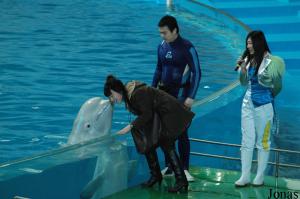
Beluga in Qingdao Polar Ocean World - February 2007

Educational methods in Shanghai Ocean Aquarium - July 2007
Breeding centres for giant pandas and other Chinese species
We cannot leave China without mentioning the breeding centres for giant pandas. This endemic species has a specialized habitat in the middle of the country. As early as the year 1970 lots of problems and conflicts with fauna emerged in this area because of the growing pressure of the human population. Many pandas had to be rescued and sent to zoos with a view to their eventual reintroduction. Some of them were kept in captivity to form the nucleus of a potential breeding population. As the number of rescued pandas was regularly increasing, the desire to know more about them and to develop further research also increased. Thus, thanks to collaboration between the Chinese goverment and theWWF, the China Research and Conservation Center for the Giant Panda (CRCCGP) was created in 1987 in Wolong, Sichuan. In 1987 Chengdu Zoo created a similar centre on the outskirts of the town, the Chengdu Research Base of Giant Panda Breeding. Finally, in December 2003, the CRCCGP inaugurated a third centre 160 kilometres south of Chengdu, the Bifengxia Base of CRCCGP. The latter forms part of the initial Wolong centre and allows the creation of a new captive subpopulation with all the conservation potential that this represents.
At the moment, the Bifengxia Base has about 20 giant pandas, the Chengdu Base about 50, and Wolong nearly a hundred. Over the years this valuable population has allowed very useful and interesting research to take place into the biology, nutrition, behaviour, reproduction and management in captivity of this species. In the last few years breeding, which was formely a very delicate process, has been gradually mastered and a little over 30 giant pandas were born in captivity in 2006, and a similar number in 2007. Artificial insemination, a very important element studied at Wolong and Chengdu, is now relatively frequent.
These numerous reproductive successes have eventually made possible the reintroduction of individuals into their natural environment. Thus, Xiang Xiang, a young panda born in 2002 at the CRCCGP, was released in the mountains of Sichuan on 28 April 2006. Despite his successful adaptation to his new environment during the first months, his dead body was unfortunately found at the beginning of 2007. The experts at Wolong concluded that the animal had had difficulties in securing his territory and finding food, and that he had been killed by other pandas. A new programme is being planned and will probably include a longer period of preparation before the animal is released into the wild.
The cost of such a programme is, of course, questionable, especially if we consider the likely results. Besides, the original habitat of the giant panda is still fragmented and deteriorating. The creation of natural corridors between the existing reserves needs to be intensified.
Finally, the breeding of animals at all costs can sometimes involve difficult decisions that endanger the individual welfare of captive animals. The vast majority of newborn pandas are removed from their mothers directly after birth and raised by keepers in modern and luxurious nurseries. But this tends to reinforce a vicious circle of behavioural and reproductive problems. Females give birth in concrete boxes, surrounded by veterinarians and keepers who want to take away the newborn at all costs. How could they possibly take good care of their young in those boxes without any chance of being out of sight of the keepers?
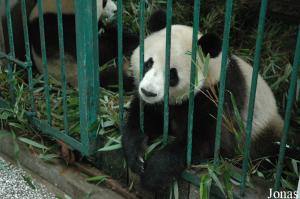
Giant panda in Chengdu Research Base
of Giant Panda Breeding - July 2007
The outdoor enclosures I have had the opportunity to visit at Chengdu and Bifengxia are probably the most appropriate exhibits for this species in captivity both in size and natural conditions; in summer, though, most of the pandas are kept indoors in air-conditioned houses because of the high temperatures due to the low altitude of the centres. The indoor cages are unfortunately small concrete areas without any possibility of hiding or sleeping peacefully. In addition, visitors are then very close to the animals.
This brings us to a final point: the education of the public. The reproduction centres are very often visited and attract a lot of foreign and Chinese tourists. In 2007 a new educational building was inaugurated at Chengdu, which offers a profusion of information. Sponsorship programmes and donations have also been well developed. Moreover, the Bifengxia Base was set up in a well established tourist area, only a few kilometres away from Bifengxia Wild Animal Park. A good balance between research centre and tourist centre seems to have been achieved, and we can hope that this balance will be maintained.
The loan of giant pandas to foreign zoos was at a relatively low level through the 1990s, in particular in Europe. But it seems very likely that the species will be more and more present in Western zoos in the coming years, thanks to the recent success of reproduction and the strong desire of zoological parks to show this emblematic species. Thus, in September 2007, Madrid Zoo welcomed two pandas, and a birth has already taken place at Schönbrunn Zoo in Vienna.
There are, of course, other endemic and emblematic species in China. Several research and reproduction centres have been created over the last 20 years under the tutelage of various major zoos, of the Chinese Association of Zoological Gardens and of the China Wildlife Conservation Association. They focus on such species as snub-nosed monkeys, François's langurs and Chinese alligators.
The famous South China tiger, considered to be the most endangered tiger subspecies, is another good example. Its status in the wild is highly vulnerable, with fewer than 30 individuals left. A breeding programme has been set up in several Chinese zoos and the captive population has now reached about 50 animals.
In 2000, Li Quan, a Chinese woman living in London, created Save China's Tigers (www.savechinastigers.org). This association has developed thanks to private funding. In 2002, a plot of 330 km² was acquired in South Africa and several Chinese tigers born in Chinese zoos were sent there in 2003 to learn how to hunt and live in a natural environment before their eventual reintroduction into the wild in China. People like Li Quan hope that the Chinese goverment will show its support by reintroducing animals as early as 2008, the year of the Beijing Summer Olympic Games. But I am a little uneasy about this programme. Is it necessary to set up a conservation program so far from China to ensure its success? Wouldn't it be better to focus on the species' remaining habitats in China while maintaining a viable captive population?
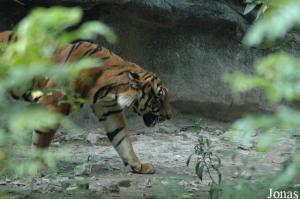
South China tiger in Shanghai Zoo - July 2007
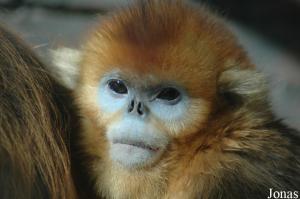
Golden snub-nosed monkey in Beijing Zoological Gardens - July 2007
Moon Bear Rescue Center, a centre for Asiatic black bear rehabilitation
Before leaving China and concluding this brief overview of Chinese zoological collections, I would like to dwell a bit on another park I visited on 14 July 2007. The Moon Bear Rescue Center is located at Longqia, about 30 kilometres north of the city of Chengdu. It was inaugurated in December 2000 by Jill Robinson, founder and president of the Animals Asia Foundation (AAF; www.animalsasia.org). In July of the same year, an agreement was signed between the China Wildlife Conservation Association, the Sichuan Provincial Forestry Department and the AAF to stop the exploitation of bears for their bile. According to this agreement, the AAF will buy the bears from the farms which agree to stop this trade and will also take back their operating licences. For their part the regional authorities state that no new licences will be granted. All this is intended to put an end to the cruel exploitation of bears for this purpose. The first bears, most of them Asiatic black bears, were quickly welcomed to the new centre. During my visit in July 2007, the centre had 180 bears housed in beautiful natural enclosures. It takes exemplary care of the animals, who are often in poor health when they arrive. Now that the centre is relatively well established and continuing to welcome new bears and build new enclosures, education is beginning to be developed. It has already received many school visits and also has a small museum about bears and their exploitation for traditional medicine. So far the visits of both local and foreign tourists have been conducted according to a previously established programme on only a few days each month, but it is now planned to open the doors to the public and increase the number of guided tours. All this is of course very important as a logical approach to the problem.
The Moon Bear Rescue Center is a superb example of a project that takes animal welfare into account, but the funds that have helped to create and maintain it all come from abroad. The majority of the employees are also foreigners. Might it not have been possible to organise the project on a more specifically Chinese basis? How do local people feel about the generous funds spent on these animals when many of them live in poverty? When the centre is more accessible to the public and thus creates closer links with the local population, it may be possible to answer these questions.
Conclusion
Our Chinese journey and the overview of the zoological collections of this country are coming to an end. As we have seen, there has been a fairly significant and especially fast evolution during recent decades. But many things still need to be improved and modified. One important topic is undoubtedly environmental enrichment, which is given so little emphasis in China. This would help to improve - quickly, simply and at relatively low cost - the everyday life of many captive animals. At Beijing Zoo a team of volunteers have recently organized themselves in order to develop enrichment methods. Collaboration and assistance from Western zoos could also be considered, as was already being done in the late 1980s, and would be valuable for both parties. Only the future will tell!
Education is also an interesting field to develop urgently. Maybe even more than in the West, Chinese zoos have an incredible potential if we consider the great number of visitors each year. The possibility of making things change, while preserving at least part of China's existing heritage, should not be neglected, in spite of the country's current frenetic pace of development. In 2007, the Yangtze river dolphin (Lipotes vexillifer), the only species of its genus and a Chinese endemic animal, was officially declared extinct. Let us hope, however, that the coming years will bring good news about the South China tiger and all the other wonderful species of this country, as well as progress in the evolution of the various zoological collections.
Jonas Livet - February 2008
- Reference sources
- ▸ Bell, Catharine E. (edited). Encyclopedia of the World's Zoos. Fitzroy Dearborn Publishers, Chicago, London, 2001.
- ▸ Blaszkiewitz, Bernhard. Zu Besuch im Zoologischen Garten Peking. Milu. 10, 2000.
- ▸ Chinese Association of Zoological Gardens. Zoos allover China. June 1995.
- ▸ Fisher, James. Le Zoo Son histoire, son univers. James Fisher Éditions RST, Paris, 1966.
- ▸ Helin, Sheng. The Mammalian of China. China Forestry Publishing House, Beijing, 1999.
- ▸ Hemin, Zhang & Pengyan, Wang. Husbandry of Giant Panda. 2003.
- ▸ Kirchshofer, Dr. Rosl. Zoologische Gärten der Welt, Die Welt des Zoo. Umschau Verlag Frankfurt am Main, Pinguin Verlag Innsbruck, 1966.
- ▸ Loisel, Gustave. Histoire des Ménageries de l'Antiquité à nos jours. Gustave Doin et Fils & Henri Laurens, Paris, 1912.
- ▸ MacKinnon, John & Phillipps, Karen. A Field Guide to the Birds of China. Oxford University Press, New York, 2000.
- ▸ Pé, Frank. An Artist Visits Two Chinese Zoos. International Zoo News. Vol. 50/5 (No. 326), July/August 2003.
- ▸ Pouille, Jérôme. Pandas - Le panda géant ou grand panda (Ailuropoda melanoleuca). http://www.pandas.fr.
- ▸ Prescott, Jacques. The Wildlife and Zoos of Chine. International Zoo News. Vol. 38/1 (No. 226), January/February 1991.
- ▸ Razemon, Olivier. Le tigre de Chine, presque disparu, tente sa dernière chance en Afrique du Sud. Le Monde. 5 février 2008.
- ▸ Reichenbach, Herman. Das Erbe der Kaiserinwitwe, Die Geschichte des Pekinger Tiergartens. Bongo. 31, 2001.
- ▸ Reichenbach, Herman. The Arks of Beijing. International Zoo News. Vol. 48/1 (No. 306), January/February 2001.
- ▸ Rosenthal, Mark. A Zoo Management Course in China. International Zoo News. Vol. 37/4 (No. 221), June 1990.
- ▸ Shai-Chung, Chiang. Le Zoo de Pékin. Revue de la Société des Amis du Muséum National d'Histoire Naturelle et du Jardin des Plantes. Feuille d'information de septembre 1962.
- ▸ The Chinese Association of Zoological Gardens in 1990.
- ▸ Wedderburn, John. The Zoo Pages. http://www.aapn.org/zoopage.html.
- ▸ Zhihe, Dr. Zhang & McManonmon, Dr. Rita. For Giant Panda, Past successes and future aspirations.
- ▸ Zhihe, Zhang & Fuwen, Wei. Giant Panda ex-situ Conservation, Theory and Practice. 2006.

